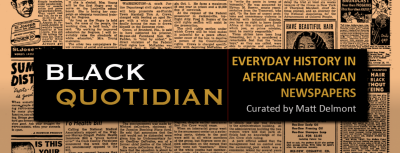Project Showcase: Black Quotidian
02 May 2016 – editors

Screenshot credit: Matthew Delmont
When 2016 began, I had never heard of Juanita Blocker, Blanche Thompson, or Helen Short. That changed once I started working on “Black Quotidian: Everyday History in African-American Newspapers,” a digital project designed to highlight moments from ordinary lives in African American history. Each day I post at least one black newspaper article from that date in history accompanied by a brief commentary. In this way, I hope to call attention to people and events that are not commonly featured in textbooks, documentaries, or Black History Month celebrations, while also casting new light on well-known stories from the African American past. The goal of the Black Quotidian project is to make these histories more familiar to more people. While I have posted on Black Quotidian about Carter G. Woodson, Rosa Parks, and Shirley Chisholm, I am most excited to learn and share the stories of people like Blocker, Thompson, and Short. Each individual’s story contributes to our understanding of the complexities of African American history and the everyday pleasures and sorrows of black lives.
The Black Quotidian project is now in its third month. The most frequent question I get is how I select articles for the daily posts. In some cases I choose a historical newspaper from a specific date and look for something interesting. I was browsing the February 20, 1969 issue of the Los Angeles Sentinel, for example, when I stumbled across a column called “Bowling Around L.A.” by Juanita Blocker. After searching through ProQuest’s Sentinel database, I learned that Blocker was the first black member of the Professional Women’s Bowling Association and that she wrote a bowling column in the Sentinel for over two decades. Who knew that the Sentinel had a regular bowling column written by a trailblazing athlete? Similarly, I was surprised to learn about dancer Blanche Thompson when flipping through the digitized issue of the Norfolk Journal and Guide from February 25, 1939. Thompson performed with the “Brown Skin Models,” a Ziegfeld Follies-style music and dance revue that featured African American dancers. Thompson was a star in the 1930s, but her name and the history of this black burlesque troupe were new to me.
I have also delved into newspaper accounts of less pleasant aspects of history. My February 14 post was on an African American family who died after their house was set on fire in Fontana, California in December 1945. I first learned about this history several years ago from Hisaye Yamamoto‘s autobiographical short story, “A Fire in Fontana.” But it was an article on the seventieth anniversary of the murders published in the Inland Valley Daily Bulletin (and tweeted by UCLA historian Genevieve Carpio) that prompted me to find a Los Angeles Sentinel article on the case. I knew from Yamamoto’s story that O’Day Short and his family were killed in the fire, but until I started writing the Black Quotidian post I did not know the names of his wife, Helen Short, or their children–nine-year old Barry and Carol Ann, aged seven. Learning these names and seeing pictures of the Short family made this tragic story more immediate–and troubling.
By using the Scalar multimedia web-authoring platform, Black Quotidian aims to bring African American history and black newspapers to new audiences in a novel format. When we teach history we make difficult choices about what to include and exclude. Black Quotidian is my small act of rebellion against the pressure to fit African American history into a single month or a fifteen-week semester. Taking the ordinary aspects of African American history seriously means recognizing the richness and diversity of black lives, cultures, and communities. I continue to be surprised by the amazing stories that live in the archives of black newspapers. With Black Quotidian, I hope to bring several hundred of these stories to web audiences and, in the process, change how I think about, write about, and teach African American history.
I welcome guest contributors to Black Quotidian, so please e-mail me if you are interested in contributing.
~ Matthew Delmont is associate professor of history at Arizona State University. He is the author of The Nicest Kids in Town: American Bandstand, Rock ‘n’ Roll, and the Struggle for Civil Rights in 1950s Philadelphia (University of California Press, 2012); Why Busing Failed: Race, Media, and the National Resistance to School Desegregation (University of California Press, 2016); and Making “Roots”: A Nation Captivated (University of California Press, forthcoming August 2016).



